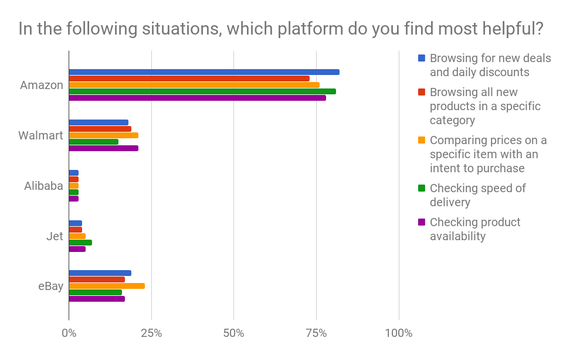This Survey Shows Just How Wide the Gap Is Between Amazon and the Competition
Amazon (NASDAQ: AMZN) is the dominant force in online shopping. Even as competitors like Wal-Mart (NYSE: WMT) step up their online retail operations with new initiatives and acquisitions, Amazon continues to widen the gap between itself and everyone else. $0.43 of every dollar spent shopping online in the United States during 2018 will go to Amazon.com, according to eMarketer.
It's one thing to see the gap in sales volume increasing; it's another to understand what exactly Amazon is doing to make that happen. Many point to the success of Prime as a reason Amazon is winning a larger share of online sales. But a survey from Feedvisor indicates Amazon is succeeding because it makes it easy for shoppers to find the information they're looking for versus its biggest competitors.

Image source: Amazon.
Anything I can help you with?
Feedvisor asked 1,500 online shoppers which of the following platforms is most helpful in certain situations: Amazon, Walmart.com, Jet.com (owned by Wal-Mart), eBay, or Alibaba.
From finding new products, to discovering deals, to price and shipping information comparisons, Amazon was by far the most popular choice. 70% to 80% of respondents chose Amazon.com for every question. Walmart.com and eBay each usually took percentages in the high teens and low twenties. Jet.com and Alibaba typically garnered favor from a low single-digit percentage of respondents.

Image source: Author, data source: Feedvisor.
Amazon simply provides a better user experience than its competitors with aggregated listings, user reviews, and built-in product comparisons. It's no wonder millennials consider the Amazon app one of their must-have apps on their phone. It makes using Amazon for price comparisons or to look up more information on a product extremely easy.
By presenting more information to its visitors about products, Amazon is able to attract a lot more visitors. That's what those survey results really mean. And attracting more visitors to the website is a surefire way to increase sales.
Amazon boosts sales by understanding why shoppers visit
Price comparison is the most popular reason for visiting Amazon.com, whether the shopper is a Prime member or not, and whether they have intent to buy now or are just considering a purchase. 75% of shoppers check Amazon for pricing either "always" or "often" before making a purchase somewhere else, according to the Feedvisor survey.
Amazon doesn't always have the lowest prices. But you can be sure Amazon knows what its competitors' prices are and which products shoppers will check prices on most. Amazon can make its prices more competitive on those products while producing wider margins on less competitive items and private-label goods.
Amazon is also actively expanding the number of items that are Prime eligible, which can be a determining factor when a customer is deciding whether to purchase from Amazon.com. 80% of shoppers said Amazon is most helpful in determining shipping speed (likely because of Prime), and 31% say a product that's Prime eligible makes them more likely to buy it from Amazon.
Amazon recently announced it now has over 100 million Prime-eligible items for sale on its website. That's up from 50 million at the beginning of 2017.
By offering shoppers more information, Amazon is able to attract more visitors. Using its data, it can optimize pricing and attract new third-party merchants to make more items Prime eligible. The foundation of driving traffic and collecting data is what's driving Amazon's sales growth, and it will continue to help Amazon widen the gap between itself and its competitors.
More From The Motley Fool
John Mackey, CEO of Whole Foods Market, an Amazon subsidiary, is a member of The Motley Fool's board of directors. Adam Levy owns shares of Amazon. The Motley Fool owns shares of and recommends Amazon and eBay. The Motley Fool has a disclosure policy.

 Yahoo Finance
Yahoo Finance 